Apr 25, 2022
Chofu’s daruma market: Quiet hope amid heaps of color at Jindaiji Temple
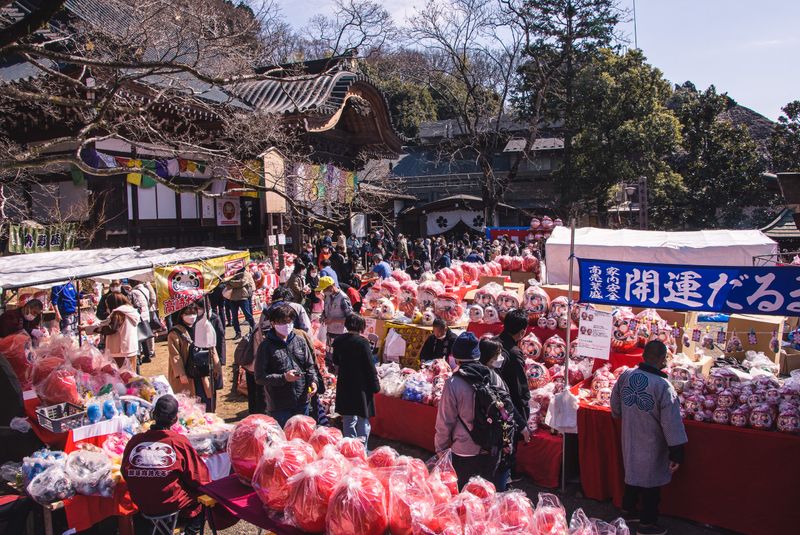
At Jindaiji Temple, in the city of Chofu, worshippers flocked to one of Japan’s largest daruma markets with eyes on finding a doll to carry their hopes for the year to come.
Widely considered to be one of Japan’s “three great daruma markets'' (along with those held in Takasaki City, Gunma Prefecture and Fuji City, Shizuoka Prefecture), Chofu’s annual Ganzandaishi Daruma Ichi once again welcomed a steady stream of worshippers over March 3 and 4, with many looking for a daruma doll to keep safe their hopes and dreams for the next 12 months.
The market forms part of Jindaiji Temple’s Yakuyoke-Ganzandaishi Taisai celebrations, honoring the Heian-period monk Ganzan who is believed to guard against bad luck. Ganzan is also said to be the creator of Japan’s popular omikuji fortunes.
In picking out a daruma doll, market visitors were spoilt for choice. Or was the choice actually rather limited? We can’t decide. During the event a myriad of daruma dolls colored the Jindaiji Temple grounds - poured out into piles, lined up rank and file, even swinging from trees. Hundreds of them in any direction, appearing in many sizes, too. But mostly available in red, and almost exclusively in the same shape.


The familiar form of the plucky daruma doll is seen as an auspicious symbol by people across Japan. Its origins go back to the figure of Daruma Daishi, according to a Jindai Temple priest we spoke to during our visit to the market. They may have been referring to Bodhidharma, a Buddhist monk believed to have been alive during the 5th or 6th century.
With arms crossed and feet together, Daruma Daishi would maintain an almost spherical repose during long periods of zazen meditation. This spherical form is reflected in the figure of the daruma doll and also means that even when knocked over, the plucky daruma always gets back up. In principle, at least.
The Japanese have a saying, “nanakorobi yaoki” - even if you fall seven times, you get up eight times. In broader terms then, ideas of picking oneself up after every fall are familiar to the Japanese and on the back of this the figure of the daruma became popular.
So to the task of picking out a daruma doll to bear the burden of this market visitor’s lofty hopes for the future. Perhaps we’ll need a big one?! (Note to self: In preparation for the next visit, have a clearer idea of what your hopes and dreams for the future are!)
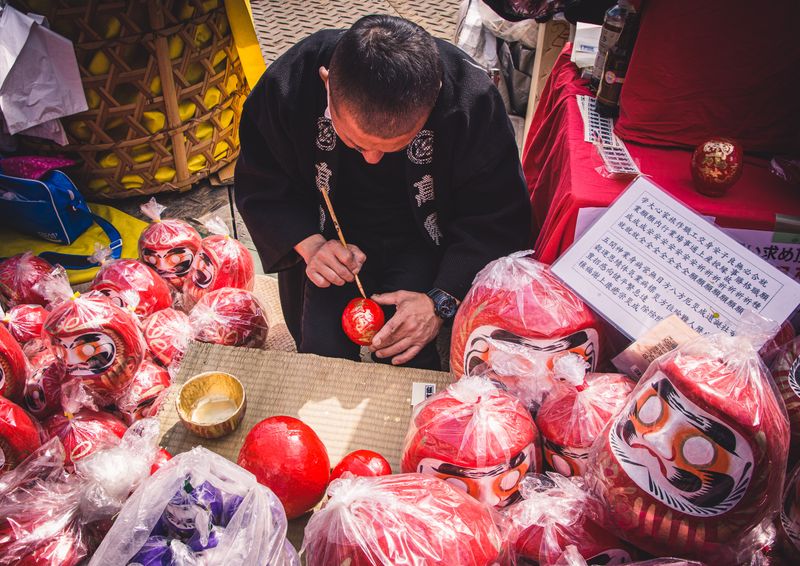
(Daruma craftsman writes hopes on a daruma doll, Ganzandaishi Daruma Ichi, Chofu.)
In terms of size for your daruma doll, anything between a table tennis ball and a basketball appeared to be available from the daruma market at Jindaiji. Maybe even larger?
“The size isn’t important. What matters is the spirit with which you put your hopes into it,” a market stall worker told us.
Actually, in more practical, monetary terms, size does matter. The larger the doll, the higher the price. This visitor’s doll was the size of a large apple and cost 800 yen. A fair price for a year’s worth of storage, I think.
While the majority of the market’s daruma dolls were red and in the image of the monk himself, there are plenty of variations to enjoy. We spotted quite a few pandas, for example. Colors and design flourishes sometimes reflected regional styles or the tastes of the maker. According to some vendors, different colors of daruma could also reflect the kind of hopes that it specializes in.
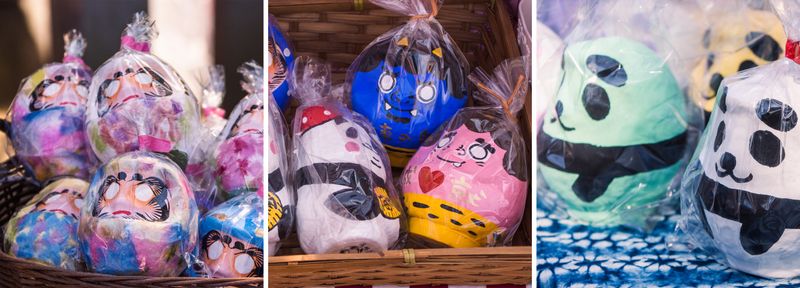
After purchasing a doll, the typical flow of the daruma market at Jindaiji Temple is to take it to a special counter in front of the temple’s Ganzandaishi Hall where priests symbolically mark one of the doll’s eyes.
We joined the fast-growing line of worshippers and their dolls outside the hall. On the approach, worshippers one-by-one bowed before a priest seated on a lofty perch who used a stick to splash a few drops of water over their heads in a purification custom known as "shasui." The Jindaiji Temple area is celebrated for its clean, fresh water, among other things. This same water, or "shimizu," was used for our purification as we approached the hall.
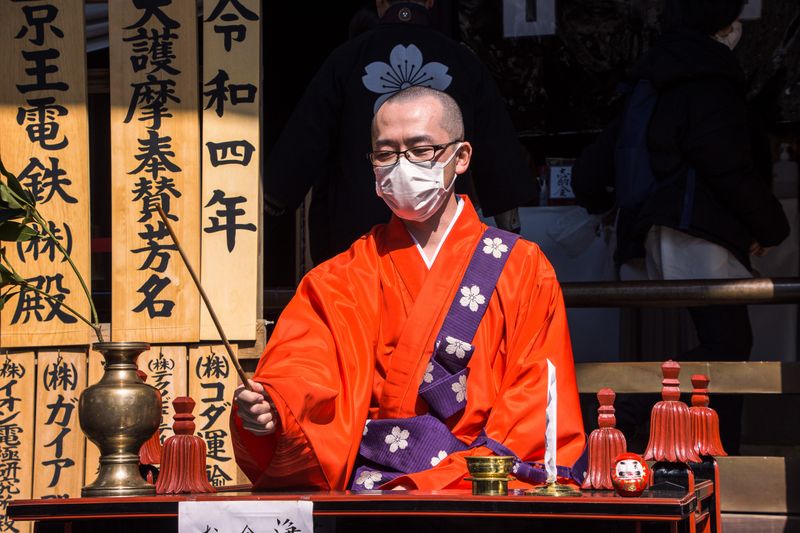
Priests at the daruma market in Chofu maintain the unique tradition of marking the daruma’s eyes using characters from bonji, the Japanese term for “Sanskrit script.” At other markets it's typical for the eyes of the daruma simply to be filled-in with black coloring.
After purchasing a new daruma doll, the worshipper has the left eye of their doll marked with the Sanskrit character for “a” (in Japanese, the “a” of “a,i,u,e,o” in the hiragana script) to represent the beginning of things. The doll is then kept at home for a year, holding the hopes and dreams of the worshipper until they come true. Upon returning to the market the following year, the character for “un” is drawn on the daruma’s right eye, representing the fulfillment of things as well as being an expression of gratitude.
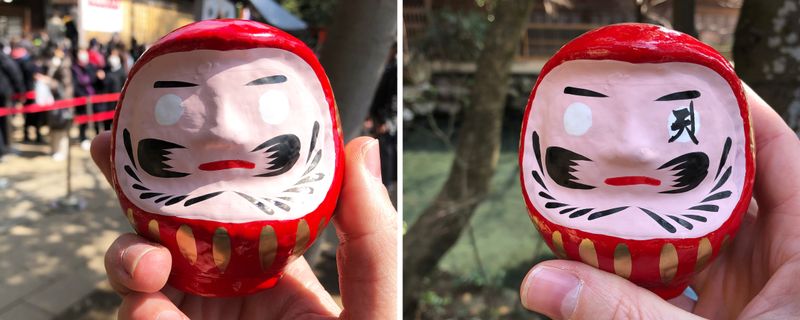
(Before and after. Daruma marked with the Sanskrit character for “a” to represent the beginning of things, Ganzandaishi Daruma Ichi, Chofu.)
“In recent years, a lot of people declare their hopes, for success or something similar, by having it written on the surface of their daruma. Actually, these hopes are something that we should keep inside us,” a Jindai Temple priest told us during our visit.
“As long as you don’t go showing it around though, and you keep it within you and contemplate it, there should be no problem.”
It also seems that returning to the market with your doll one year later is also not a hard-and-fast rule.
“Some people find a daruma that they really like and keep it for two or three years until they reach their goal. They then come here to have the mark of fulfillment drawn on it. It’s OK to do this, too,” the priest said.

(Talking daruma with a priest at Jindaiji Temple, Chofu.)
The connection between the city of Chofu and daruma goes back to the city having once been a center for sericulture - cultivation of silkworms to produce silk thread. (The kanji characters that make up the city’s name - 調 and 布 - can be interpreted as carrying the meaning, “prepare cloth.”)
The shape of the cocoon from which the thread was extracted was said to resemble the daruma doll. People believed then, that the dolls were auspicious in helping the cocoon to grow well, making them a sought-after item. During the Edo period (1603 - 1867) the daruma became like a good-luck charm in the Chofu area. A daruma market has been held in the city ever since, according to the priest.

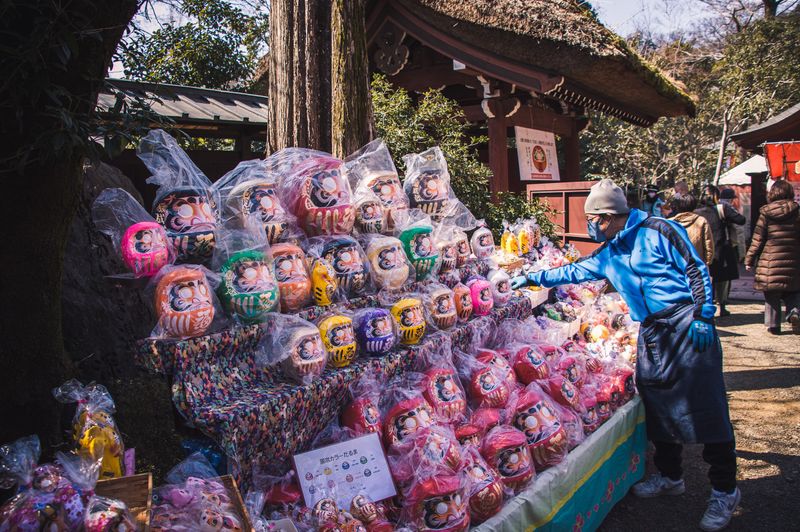
Yakuyoke-Ganzandaishi Taisai events have continued even during the novel coronavirus pandemic. In an effort to reduce crowding however, an event parade known as the Oneri Gyoretsu has remained canceled since the outbreak of the virus. The original purpose of the parade was to carry offerings of grain around the temple grounds, presenting them to Ganzandaishi.
Despite the absence of the parade, the atmosphere inside the grounds of Jindaiji Temple during the market was lively and the sight of all the daruma was one that the visitor will be unlikely to forget any time soon.
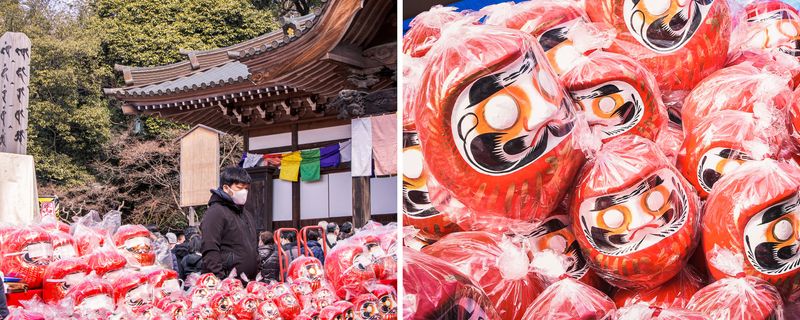
Outside the temple grounds, the narrow streets that branch off from Jindaiji’s sando approach were lined with colorful food stalls, steaming and smoking with traditional festival fare.
As well as the daruma dolls and the festive food, another item of interest at the market was the Daruma Ichi “shuin,” one of the stamps collected at shrines and temples across Japan. This particular shuin was exclusive to the Yakuyoke-Ganzandaishi Taisai celebrations and featured a daruma bearing the image of Ganzandaishi.
During our visit, the shuin was being sold at the temple office, pre-stamped onto traditional paper. It also came with a sange - paper in the shape of a lotus petal, typically scattered as an offering to the Buddha.
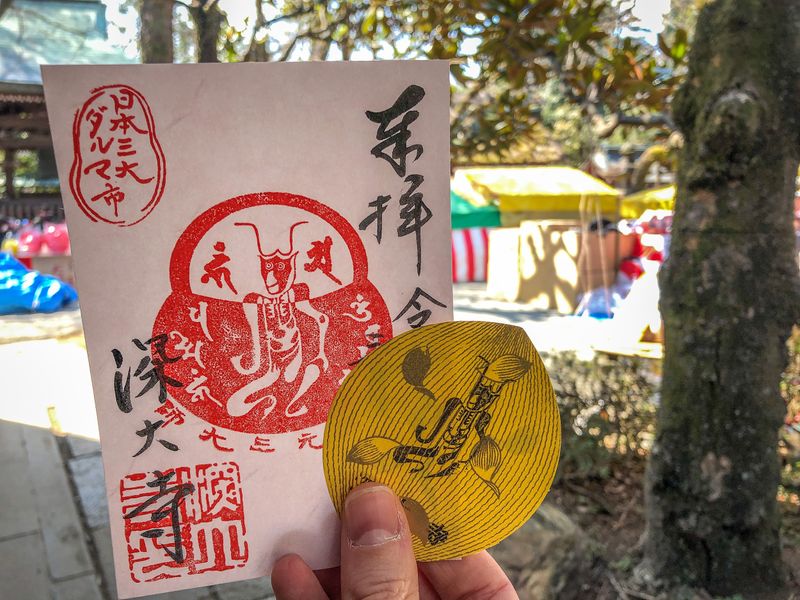
(Limited-edition Daruma Ichi “shuin,” Ganzandaishi Daruma Ichi, Chofu.)
Amid the mountains of daruma, the riot of reds, and the “greatest three in Japan” boast, there was something rather endearing going on at the market. An unspoken, quiet, and very human admission that we might need some help, however slight, in realizing our hopes.
“As a priest and as a human being, I am really happy to see people from other countries interested in Japanese culture, and since we are all human beings, we all have the same worries and wishes,” our Jindaiji priest said.
“Whether it’s Japan or another country, it doesn’t matter. This is something we put our heart and soul into, having the characters drawn onto our daruma. I hope that the people from overseas who come here can fill the daruma with hopes of their own.”
I’d say these daruma bear quite a precious load for quite a long time then. It’s a good job they’re experts at getting back up from a fall.
This article was supported by Chofu City.



0 Comments